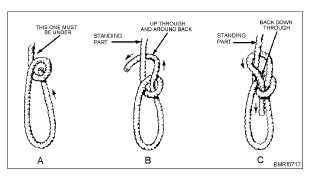Becket Bend
The chief value of the becket bend is its use in
binding together two lines of different sizes. If there is a
great difference in sizes or the strain on the line is to be
great, always use a double becket bend.
To fashion a single becket bend, you should—
1. Make a bight in one line and run the bitter end of
the other line up through it, as shown in figure
7-18, view A.
2. Pass the end around behind both parts of the
bight and back under itself (fig. 7-18, view B).
Figure 7-18, view C, shows how you make a
double becket bend by simply taking another turn
around the bight. (These bends are also known as sheet
bends.)
Clove Hitch
The clove hitch can be quickly and easily tied in
several ways, and it will hold as long as there is a
strain on it. Once the strain is taken off, however, the
hitch must be checked and tightened to prevent the
bitter end from pulling out when the strain is
reapplied. To make this checking and tightening
unnecessary, you lash a clove hitch with a half hitch
around the standing part.
To tie this hitch (fig. 7-19), you should—
1. Take a turn with the bitter end.
2. Pass the end across the standing part.
3. Take another turn. (Notice that both turns go
around in the same direction.)
4. Pass the end under itself, and the hitch is
complete.
Another way to make this hitch is to form two
underhand loops. Lay the second loop on top of the first.
This method is the usual way to form the hitch when it
can be slipped over the end of the object to which the
line is to be secured.
Round Turn and Two Half Hitches
The chief advantage of the round turn and two half
hitches over other hitches is that it won’t slip along the
object to which it is secured. It’s made by taking a round
turn and making two half hitches (fig. 7-20). (The two
half hitches actually consist of a clove hitch taken
around the line itself.)
7-12
Student Notes:
Figure 7-19.—Tying a clove hitch.
Figure 7-18.—Single- and double-becket bends.
Figure 7-17.—Tying a bowline.







